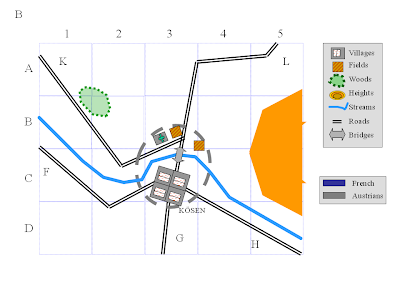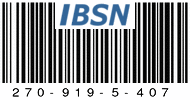And the Kosen winner is....
The next game will be a Lasalle battle 'The crossing point. Kösen. October 21, 1813'. The scenario is an adaptation of the C.S. Grant’s ‘Crossing Point’ scenario of his book ‘Programmed Wargames Scenarios'(Wargames Research Group, 1983) but located after the battle of Leipzig. Summarising up, the French must to destroy a bridge to cover their retreat, whereas the Austrians, which have seized it previously, try to prevent it.
As indicated in a previous post (See this post) all the Scenarios of the book “Programmed Wargames Scenarios” are heavily randomised, giving a different game each time. The map, deployments an orders below was one of the four designed after rolling all the required dice in the Gran’s Scenario altough an EXCEL spreadsheet was used instead, when applicable.
Due to the different scales, the actual procedures were a combination of Gran and Lasalle ones. Bold sentences refer to Gran’s scenario. The full OOB appears in he previous post on Kosent and the AAR of a previous re-fight, done with a home divisional version of Napoleon's Battles ,can be found at the main web site, or in the posts of this blog with the label Kosen.
Deployment
Austrian (blue) forces
- Its mission is “to hold the crossing point” in order to ensure the bridge over the Elster, thus allowing them to outflank the retreating Grande Armée.
- The Vanguard (all the Infantry units of the Light Division plus its Brigade commander) must be deployed on th table “50% north and 50% south of the river”. Their orders allow for “A flexible defence with the ability to respond to attacks, follow up and counter attack. Well ordered and controlled withdrawal if required”.
- Reinforcements: the rest of the units (: Chevaux-Leger No.5; Chevaux-Leger No.7 plus Horse battery; IR No.8 plus Brigade battery; IR No.7; IR No.37 and IR No.60 plus Brigade battery. The normal arrival procedure (p. 91 of the e-Lasalle book) is used.When a unit arrives, a dice will indicate the entry point with 1 or 2 being F, 3 or 4 being G and 5 or 6 being H. The first unit in a brigade marks the enter point used by the others units in the same brigade.
- All the Austrian reinforcements will enter in march column formation The Brigade commanders arrive with their first arriving unit, Divisional commanders will enter with their first or second arriving brigade (50%/50%). The C-i-C will enter with his first, second or third arriving brigade (20%/30%/50%).
- The orders for the reinforcementes depend on the situation at the bridge:
Situation good (no danger to the crossing point) Reinforcements disciplined and deploy as ordered
Situation in balance (50/50) Reinforcements rush exuberantly into the battle
Situation bad (crossing point about to be lost) Reinforcements rush exuberantly into the battle
French (red) forces
- Its mission is “to seize and destroy the crossing point".
- There are no French units on the table at the start so all enter as reinforcements. The arrival Lasalle procedure is slightly modified: “Take the number of the current turn. Add to this the Vigor modifier of the subcommander in command of that reserve force. Then roll one die, and if it is less than the modified turn number, the reserve force has arrived “
- The order of march is the following:
Point K: 1/12th; 2/12th; 3/12th; 12th Division battery Division; Young Guard Light Cavalry; Old Guard Horse Artillery
Point L: 38th Wurttemberg; 15th Italian Division Division
- Each Brigade commander enters with his brigade. Each Divisional commander enters with his first division. Morand can arrive with his first, second or third arriving brigade (50%/30%/20%). Bertrand enters along Morand.
- The initial Bertrand’s battle plan is “Advance to medium range and send forward a parley party under white flag to debate the crossing. If this is rejected then a unit of cavalry, close at hand, should attempt to rush the crossing by surprise”.
- However, “the response to the arrival of reinforcements will cause varying stages of increased urgency in his attempt to achieve the objective. A single dice throw for each enemy unit to appear will provide a gradually accumulating score which will reflect the response of the Red Commander.
Less than 10: no change in orders or activity.
10-20: increased urgency. Troops in charge range will come to contact. Troops still not deployed will advance at 'forced march'.
21-35: attempt to seize crossing immediately. Troops still not deployed well forward will 'double' forward.
36-50: panic attack on crossing by all forces which if repulsed will result in disorder and poor morale.
51 or more: all attempts to storm bridges will falter and retire. Assaults will break down into fire-fights and forward movements will cease.”
Watch this thread!
P.S. By the way, the winner was.... Scenario number two



































No comments:
Post a Comment